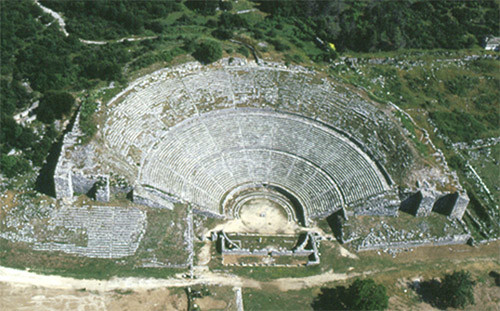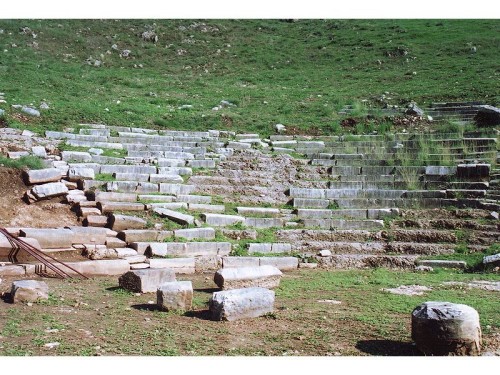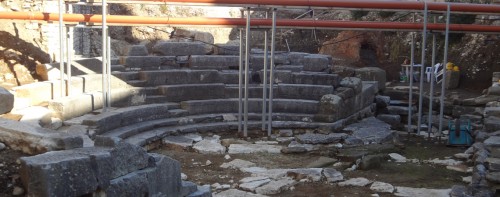The creative collaboration between AUEB and Diazoma bears fruit
Project Lavrio year 2023-2024. Completion of the innovative action “Education, Entrepreneurship and Culture” for the academic year 2023-2024 between the Teacher Education Program of AUEB, the Association “Diazoma” and the collaborating bodies
Elafonisos Eco Week; 10 – 16 June 2024
Spring Rites and the Crocus Collectors of Thera
Demolition of the Expropriated Buildings on the Site of the Ancient Theatre of Acharnes Commences
A cultural itinerary is a specialized and branded tourism product, a product of cultural tourism, which takes form on the basis of a specific binding element.
Diazoma’s proposal involves the organization in a first pilot stage of a cultural itinerary focusing at the ancient sites for viewing and listening in Epirus. The aim is to use this itinerary as a model for similar cultural routes in other parts of the country.
According to the latest strategic marketing study of Greek Tourism (preparation by PRC-MRB and THR Spain, 2007) commissioned by the Greek National Tourism Organization (GNTO), the country needs to focus on creating specialized branded products in the form of itineraries or networks. This has not been sufficient to date.

In the field of cultural tourism there is not such kind of products from the dozens that could be organized, with the sole exception of the so-called “classic trails.” The reason is mainly the lack of intervention by an entity that can take over the management of the project. This entity is either a private sector agency, ie a destination management company (DMC), which according to Greek legislation could be a legitimate travel agency, or an agency of the wider public sector, namely a destination management organization (DMO) that could be a development company or any other public or private non-profit organization. Without the involvement of a DMO organizing such a project is not possible, as there is only a handful of cases in which private actors -DMCs- undertook the relevant investment and business risk.
As a specialized tourism product cultural itineraries require organization and market positioning, which of course cannot be done by the central government nor the GNTO at least in its current form. But before all this, it requires the selection of the cohesive element, of the places visited, documentation, which will facilitate not only the guided tours, but also the creation of printed and electronic information material. It also requires organizing the visits to the archaeological sites, along with having minor interventions around them. Documentation is very important, considering that the tourist clientele of an itinerary is usually not – or not only – the so-called general public, but people with specialized interests, e.g. archaeologists, historians, etc.
Positioning an itinerary to the market of domestic and inbound tourism as a niche product of cultural tourism is done by travel agencies, which organize and necessary trips, hotel bookings, meals etc. In this way they offer the product in a complete form.

In collaboration with the Region of Epirus, Diazoma undertook to devise such an itinerary, and find how to carry it out. This followed consultations with the Ministries of Development – Culture – Tourism and an agreement to use GNTO services. Therefore this is an itinerary that is essentially promoted by the three ministries and the GNTO (which intends to support the project’s first steps, with promotional activities and public relations services) and implemented by the Region of Epirus and Diazoma.
Diazoma will choose a “route,” combining visits to ancient theaters and corresponding archaeological sites and museums will obtain the documentation and prepare the non-touristic part of the program of visits. The non-touristic part includes texts and audiovisual material for 5 printed booklets (one per archaeological site and a one for the overall itinerary), two little posters and the node path. There is also provision to record the first small interventions required to improve accessibility to sites and the cultural experience. These interventions include the necessary information signs, minor accessibility interventions etc. They also include the concept and the terms for the selection of the advertising agency that will design the logo and the creative part of the itinerary’s printed and electronic material.
It is obvious that Diazoma cannot organize the touristic (commercial) package of the itinerary, namely to assign the tourist services (tourist buses, hotels, catering, etc.), or to go into the time schedule of the visit (for example, one day or more), with the sole exception on the schedules of visits, which will be specific and agreed with the relative local Ephorate of Antiquities. Consequently, the tour package will be given to one or more travel agencies.
It should be noted that any tourist or travel agency (according to Greek legislation only legitimate travel agencies can organize excursions and guided tours on a commercial basis, L. 393/76, art.1) could have organized or organize any time in the future such an itinerary. To date, this has not happened, except occasionally to one or two theatres in Epirus. On the other hand, the aim is not to simply organize an excursion, but to offer a “branded tourism product” of high quality, with the “guarantee” of the official state, the competent local authority – the Region in this regard – and a cultural institution like Diazoma, which gives it “added value” and will provide the necessary quality factor in the minds of potential tourists.
It should be mentioned right from the start that the endeavor to design such am itinerary in Epirus, in a rather non-tourist region of the country (despite considerable tourist destinations on the coast), is not easy because there is no concrete tourist clientele in size, as is the case in other areas, like Attica, Crete, etc.
This, however, is what makes the whole endeavor more important and original for the region. The anticipated tourist clientele, which will be targeted by the itinerary’s marketing, is largely domestic, but also inbound in smaller numbers: these are people of high educational level and cultural interests, who belong either to the general public, or to a niche audience of historians, archaeologists, architects, as well as theatrologists, directors, actors, etc.
The tasks undertaken by Diazoma for the Region make up an integrated project, a “file” that is already underway. The same file will be submitted for approval to the Central Archaeological Council of the Ministry of Culture. Moreover, Diazoma will promote the e-tour of the itinerary with a relevant application, as it has already done for the sites of Ancient Messene, Epidaurus and Delphi.
Given that this product should be of high quality standards, it was agreed that Diazoma would create specific conditions, namely the preparation of a Draft Call for Interest for the realization of the itinerary on behalf of one or more tourist agencies, which has also been completed. The aim is to have excellent quality guided tours (“excellent quality” does not necessarily mean “luxury”) with the highest probability of success right from the start. More specifically:
All the above consist a set of organizational actions in the context of a program for the design and operation of a cultural itinerary, at a first – direct – level. At the same time, there are attempts to complete the itinerary with the necessary interventions to the required infrastructure, such as:
Interventions also needed in the area of the monuments are:
At a medium term level the intention is to integrate the necessary projects in the Support Program of the 5th Programming Period (Partnership Agreement 2014-2020).
We hope that this approach will be the basis for the incorporation of other similar itineraries into EU funding programs, provided that they are in line with the philosophy of the Partnership Agreement, meaning that they link cultural elements to sustainable development and the real economy, namely one of the most dynamic industries of real economy, which is tourism.
